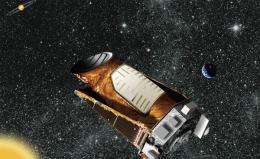Exoplanetary systems

(PhysOrg.com) -- There are now about fifty stars known with more than one orbiting planet - they are the exoplanetary equivalents of the solar system. These stellar families are critical to astronomers piecing together the origin and evolution of the Earth because, among other things, they shed new light on the stability of multiple-planet systems and how the planets interact with each other.
Almost all of these groups were detected using the traditional methods that analyze tiny stellar wobbles as the planet (or planets) orbits.
The other prolific technique of extrasolar planetary detection is based on planetary transits, but at least from ground-based telescopes this method introduces a number of important biases because the searches cannot be conducted continuously, or for long enough times.
The Kepler satellite is currently staring continuously at about 150,000 stars, looking for transits. CfA astronomers Lars Buchhave, Daniel Fabrycky, Francois Fressin, Matt Holman, Dave Latham, Samuel Quinn, and Dimitar Sasselov have announced with their colleagues that Kepler has identified five new candidate, exoplanetary systems.
After describing many of the possible extraneous effects that could confuse the data analysis, the team concludes that, pending confirmation, one of the new systems has three new planets in it and the other four have two planets each (one of them possibly a super-Earth).
The new results highlight the productivity of Kepler and the abundance of multiple-planet systems in the universe. The precision of Kepler offers scientists the promise that, with further observations, slight changes in the orbital parameters caused by the mutual interaction between planets might be detected.
Provided by Harvard-Smithsonian Center for Astrophysics




















